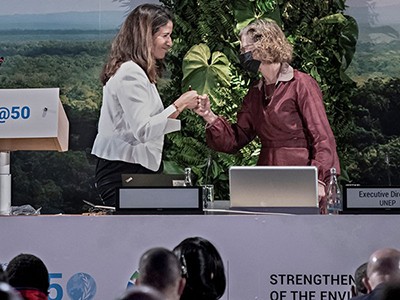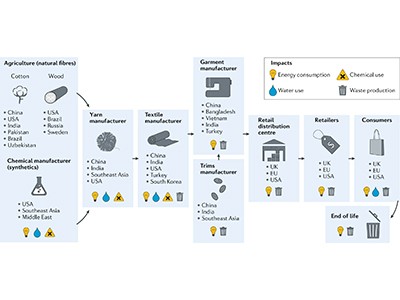Clothes were once used until they fell apart — repaired and patched to be re-used, ending their lives as dishcloths and oil rags. Not today. In high-income countries in particular, clothing, footwear and upholstered furniture are increasingly frequently bought, discarded and replaced with new fashions, which are themselves soon discarded and replaced.
The proof is there in the data. In 1995, the textiles industry produced 7.6 kilograms of fibre per person on the planet. By 2018, this had nearly doubled to 13.8 kilograms per person — during which time the world’s population also increased, from 5.7 billion to 7.6 billion people. More than 60 million tonnes of clothing is now bought every year, a figure that is expected to rise still further, to around 100 million tonnes, by 2030.
‘Fast fashion’ is so called partly because the fashion industry now releases new lines every week, when historically this happened four times a year. Today, fashion brands produce almost twice the amount of clothing that they did in 2000, most of it made in China and other middle-income countries such as Turkey, Vietnam and Bangladesh. Worldwide, 300 million people are employed by the industry.
But incredibly, more than 50 billion garments are discarded within a year of being made, according to a report from an expert workshop convened by the US National Institute of Standards and Technology (NIST), published in May.

Landmark treaty on plastic pollution must put scientific evidence front and centre
Textiles fit into two broad categories: natural and synthetic. The production of those such as cotton and wool, which are made from plant and animal sources, is largely stable, albeit slowly increasing. By contrast, the production of polymer-based fibres, particularly polyester, raced ahead from about 25 million tonnes a year in 2000 to some 65 million tonnes in 2018, according to the NIST workshop report. Taken together, these trends are having a staggering environmental impact.
Take water. The fashion industry, one of the world’s largest users of water, consumes anywhere from 20 trillion to 200 trillion litres every year. Then there are microplastics. Plastic fibres are released when we wash polyester and other polymer-based textiles, and make up between 20% and 35% of the microplastics choking the oceans. Added to this are specific chemicals, such as those used to make fabrics stain resistant and the pesticides required to protect crops such as cotton.
Change is sorely needed, but will require the fashion industry to work harder to embrace more of what is known as the circular economy. That will involve at least two things: refocusing on making things that last, and so encouraging reuse; and more rapidly expanding the technologies for sustainable manufacturing processes, especially recycling. There’s a big role for research — both academic and industrial — in achieving these and other ambitions.
Researchers could begin by helping to provide more accurate estimates of water use. It must surely be possible to narrow the range between 20 trillion and 200 trillion litres of water. There is also work to be done on improving and expanding textiles recycling. Overwhelmingly, used textiles go to landfill (in the United States, the proportion is around 85%), in part because there are relatively few systems (at scale) that collect, recycle and reuse materials. Such recycling requires the manual separation of fibres, as well as buttons and zips. Different fibres are not easy to identify by eye, and overall such manual processes are time-consuming. Machinery is being developed that can help. Technologies also exist to recycle used fibres chemically and to create high-quality fibres that can be reused in clothing. But these are nowhere near the scale needed.
Another challenge for researchers is to work out how to get consumers and manufacturers to change their behaviour. This is already an active area of study in the social and behavioural sciences. For example, Verena Tiefenbeck at Bonn University in Germany and her colleagues found that when hotel guests were shown real-time feedback on the energy used in taking a shower, it cut down energy consumption from showering by 11.4%1. Other research questions include finding ways to encourage people to purchase durable goods; exploring how to satisfy cravings for something new while reducing environmental impact; and understanding why certain interventions can be successfully scaled up whereas others fail.

The environmental price of fast fashion
Industry and academia could also collaborate to establish a system to track textile microplastics. This could be done digitally, for example. It would require an agreed definition of what constitutes textile microplastics, such as their material composition and dimensions. Companies, universities, campaigners and governments also need to consider how to make their technologies more accessible. Doing so would accelerate development and testing, and (eventually) adoption at scale.
There are also schemes in other fields that could be a source of ideas. The World Health Organization has considerable experience where accessibility is concerned, for example, in its Access to COVID-19 Tools Accelerator. Through this, companies and governments agree the principles of sharing key technologies in diagnostics and drug development. And in the early 2000s, the Rockefeller Foundation, under its then-president Gordon Conway, an ecologist now at Imperial College London, made a big push to encourage companies to share technologies in agricultural biotechnology, by establishing the African Agricultural Technology Foundation. These schemes are not perfect and are continually evolving, but offer ideas and lessons that should be studied and considered.
In the meantime, campaign groups are doing much of the heavy lifting with industry. The Ellen MacArthur Foundation, a UK-based charity that promotes circular-economy solutions, is in the second iteration of a campaign called the Jeans Redesign, which challenges clothing manufacturers to come up with circular solutions to that stalwart of every wardrobe. Some manufacturers have made their jeans-production process more circular by using organic cotton, and by inserting zips in a way that allows them to be easily removed when clothes are recycled. Others are using reinforced stitching to make their products last longer. These are important proofs of principle, but such techniques need to become mainstream.
These actions come at a cost and challenge the idea of fast fashion, because they could make items less affordable to consumers looking to keep up with latest trends. Brands and retailers take a serious view on risks to their bottom line (and might choose to delay action on sustainability as a result). This is why government action is key.
Policies need precision and teeth, which current ones do not always have, and should, ideally, be coordinated. A recommendation from the European Union for member states, for example, says that by 2030 there need to be “mandatory minimums for the inclusion of recycled fibers in textiles, making them longer-lasting, and easier to repair and recycle”. This is too vague. Without more specific targets it will be very difficult to track for compliance purposes. China, the world’s largest textiles producer, also has a five-year circular-economy plan for the industry. Considering fast fashion’s interconnectedness, China and the EU, together with the United States and others, must try harder to coordinate their efforts.
Small steps are good, but big changes are needed. There’s no time to waste when it comes to changing textiles manufacture and design. The shameful environmental cost of a whizzy new wardrobe needs to be tackled immediately, at scale, with style and panache.

